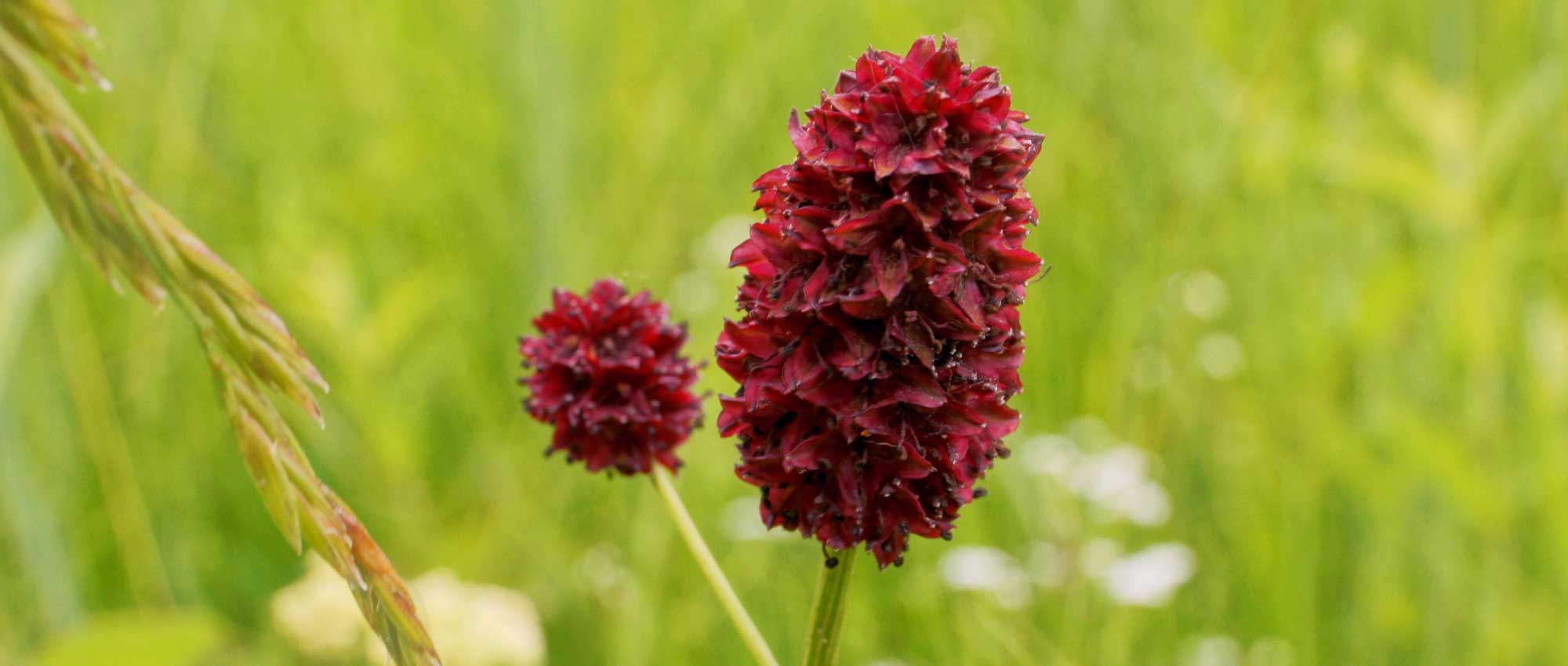
Burnet or Sanguisorba : planting, cultivation and maintenance
Contents
Sanguisorbas in a nutshell
- Pimprenelles or sanguisorba offer, in summer, graphic flowers in spikes that are more or less elongated.
- The very elegant flowering ranges from white to dark purple, with beautiful shades of pink and red in between.
- It is a solid and durable perennial that lives for many years in gardens.
- The sanguisorba is a plant with a wild style, perfect for naturalistic gardens!
- The small pimprenelle, Sanguisorba minor, is medicinal and edible!
A word from our Expert
Also known as burnet, sanguisorba is a rhizomatous perennial that offers delicate flowering in summer with oval or elongated spikes. These spikes can take on shades of red, pink, purple, or white. It also features attractive foliage divided into dentate leaflets. With its wild plant appearance, it is ideal for naturalistic gardens and when paired with grasses. Few plants offer such lightness, reminiscent of the short, purplish spikes of Sanguisorba officinalis ‘Tanna’. Sanguisorba bears small pom-poms at the end of long, slender stems that seem to float, dancing with the wind.
While the most well-known are undoubtedly Sanguisorba officinalis and Sanguisorba minor, burnets offer a beautiful diversity: from the trailing, pink spikes of Sanguisorba obtusa and Sanguisorba canadensis to the long, upright, pure white spikes of Sanguisorba canadensis, not to mention the dark pink, upright spikes of Sanguisorba menziesii… the choice is vast, and the effect in the garden will vary greatly from one variety to another!
Easy to grow, sanguisorba is a relatively undemanding plant. It is rarely affected by diseases but is particularly vulnerable to slugs and snails. The small burnet, Sanguisorba minor, tolerates drought very well and can be planted in a rockery, while most other varieties prefer cool soils. Sanguisorbas can naturalise! Furthermore, the small burnet, Sanguisorba minor, is an excellent medicinal and edible plant. Its leaves can be consumed in salads. It was once cultivated in kitchen gardens.
Botany
Botanical data
- Latin name Sanguisorba sp.
- Family Rosaceae
- Common name Sanguisorba, Salad burnet
- Flowering summer
- Height up to 2 metres
- Exposure full sun or partial shade
- Soil type cool and well-drained, preferably calcareous
- Hardiness -15 to -25 °C
The sanguisorbas are perennial plants that originate from temperate regions of the Northern Hemisphere. Sanguisorba minor and Sanguisorba officinalis are found in France, but their ecology differs as the former grows in dry short grass meadows and calcareous scree, while Sanguisorba officinalis is more commonly found in wet areas. Other species frequently cultivated come from North America (Sanguisorba canadensis), Japan (Sanguisorba obtusa) or Alaska (Sanguisorba menziesii). Many species are native to Northern Asia.
There are between 20 and 30 species of sanguisorbas. Etymologically, Sanguisorba comes from sanguis: blood, and sorbere: to absorb, as this plant has the property of stopping bleeding and aiding in wound healing. The small salad burnet, Sanguisorba minor, is sometimes classified under the genus Poterium, and referred to as Poterium sanguisorba (synonym). The sanguisorba belongs to the rose family, the Rosaceae. This family includes most cultivated fruit trees, as well as many wild plants that can be found in France: tormentil, agrimony, bramble, meadowsweet, wild rose…
The sanguisorbas form a tuft of leaves above which the floral stems rise, flexible and slender. They can reach up to 2 metres in height, as is the case with Sanguisorba canadensis. Others are much smaller, such as Sanguisorba minor, which measures between 30 and 60 cm in height. The stems of the sanguisorba are knotted, branched, and sometimes take on a reddish hue.
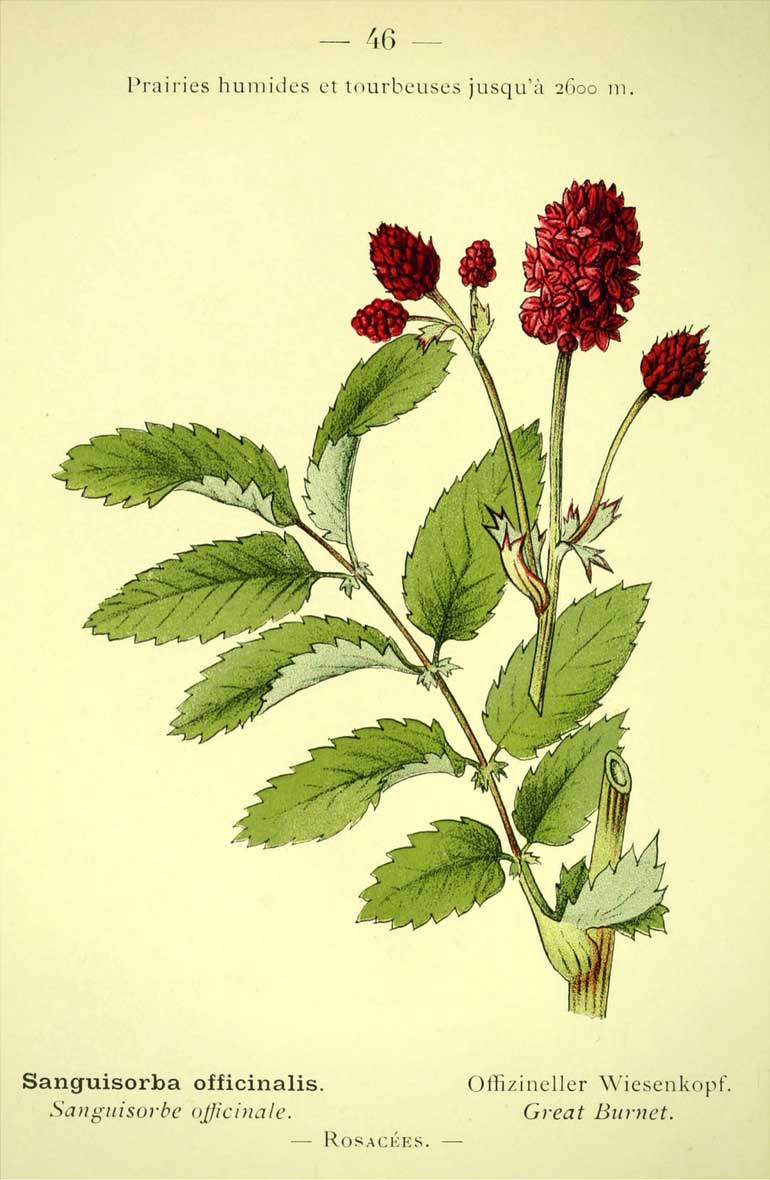
Sanguisorba officinalis: Botanical plate
Depending on the varieties, the sanguisorbas bloom between May and September-October. The small salad burnet is among the first to bloom, starting in May-June, while other species and varieties are often a bit later. Sanguisorba tenuifolia var. purpurea blooms from August.
The sanguisorbas bear their floral spikes at the end of long, slender, flexible stems. The very airy structure of the sanguisorba allows the view to pass behind the stems, giving the impression that the spikes are suspended in the air. The floral stems of the sanguisorba are ideal for composing bouquets, so feel free to use them for that purpose!
The flowers of the sanguisorba are small and grouped in dense spikes. Generally, the flowers have no petals. It is the sepals and stamens that are decorative. The sepals are often green, pink, or red, and resemble petals (petaloid sepals). The flowers consist of four sepals, four stamens for male flowers, and one style for female flowers.
The floral spikes can be white, pink, red, or purple, and sometimes lean more towards brown or violet. The varieties with white flowers are particularly elegant, and the flowering of Sanguisorba tenuifolia ‘Alba’ somewhat resembles the floral spikes of grasses! As for Sanguisorba obtusa, it offers bright pink spikes that contrast with the often softer colours of other varieties. Sometimes, the flowering is dark and quite intense, as seen in sanguisorba ‘Tanna’.
The length of the spikes varies considerably. When they are long, they take on a “bottlebrush” appearance, while short, ovoid, or spherical spikes resemble small pom-poms. In Sanguisorba minor, they measure only one centimetre in diameter, but they can reach 20 centimetres in length in Sanguisorba canadensis. The spikes are often upright, but they can also be trailing.
Sanguisorba officinalis is the host plant for two butterflies: the Marsh Fritillary (Maculinea nausithous) and the Sanguisorba Blue (Maculinea teleius). They are protected in France and need the sanguisorba to complete their life cycle. This plant is therefore important ecologically.
Depending on the different species, the pollination of sanguisorbas is carried out by insects (entomophilous pollination) or by the wind (anemophilous pollination).
The sanguisorba has very decorative leaves, divided into dentate leaflets. They are alternate and can measure up to 30 centimetres long. They have an odd number of leaflets (they are odd-pinnate): between seven and twenty-five, with one leaflet in the terminal position. In Sanguisorba minor, the leaflets are small and rounded, while they are oblong or elliptical in most other species. Sanguisorba tenuifolia has superb foliage, composed of very fine and elongated leaflets.
The leaves have a lovely light green colour. They are sometimes bluish. There are also variegated varieties, such as Sanguisorba ‘Little Angel’! The variety Sanguisorba menziesii ‘Dali Marble’ has foliage with a fine white border around the edges of the leaflets.
The leaves of Sanguisorba minor are edible, with a cucumber-like taste, and can easily be consumed in salads.
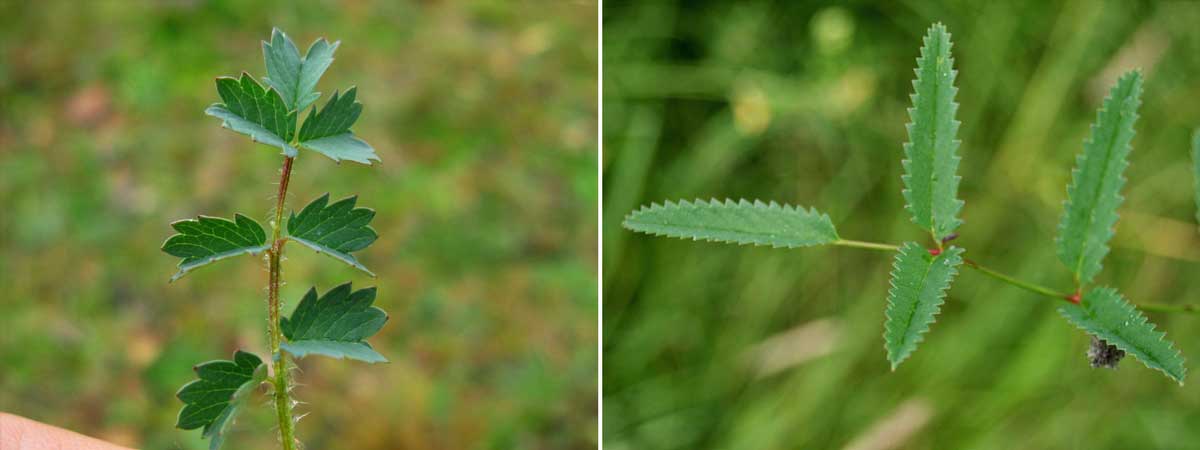 The foliage of Sanguisorba minor (photo Harry Rose) and Sanguisorba officinalis (photo Danny Steven S.)
The foliage of Sanguisorba minor (photo Harry Rose) and Sanguisorba officinalis (photo Danny Steven S.)
The sanguisorbas have rhizomes (underground stems growing horizontally), which allow them to spread.
After flowering, the sanguisorba bears small dry fruits with four angles. These are achenes: dry fruits that do not open at maturity and contain a single seed.
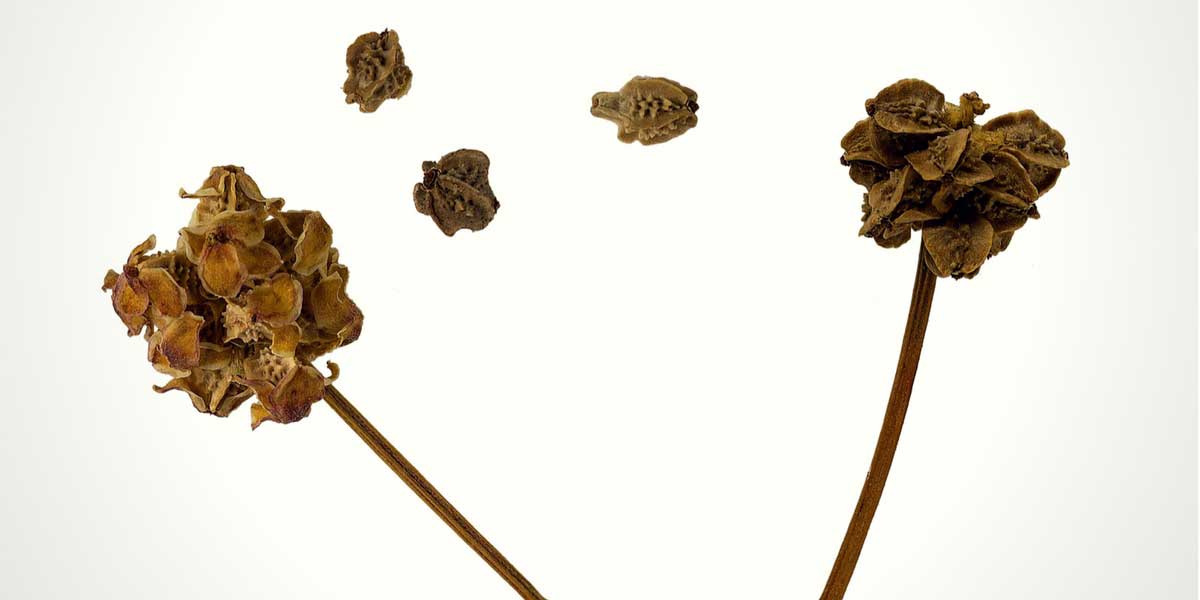 The fruits and seeds of Sanguisorba minor (photo Roger Culos – Museum de Toulouse)
The fruits and seeds of Sanguisorba minor (photo Roger Culos – Museum de Toulouse)
The main varieties of Sanguisorba
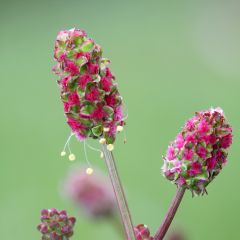
Sanguisorba minor
- Flowering time June, July
- Height at maturity 50 cm
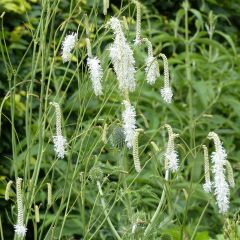
Sanguisorba tenuifolia Alba
- Flowering time August to October
- Height at maturity 1,50 m

Sanguisorba officinalis Pink Tanna
- Flowering time August, September
- Height at maturity 60 cm
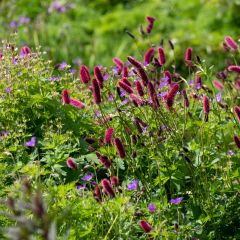
Sanguisorba officinalis Tanna
- Flowering time August, September
- Height at maturity 40 cm
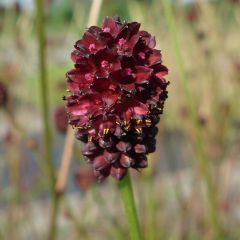
Sanguisorba officinalis Chocolate Tip
- Flowering time June, July
- Height at maturity 1 m
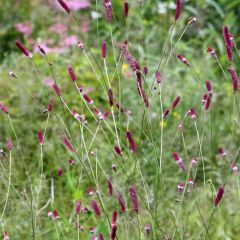
Sanguisorba menziesii
- Flowering time June, July
- Height at maturity 1 m
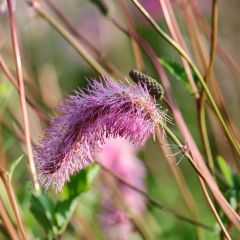
Sanguisorba obtusa
- Flowering time August to October
- Height at maturity 50 cm
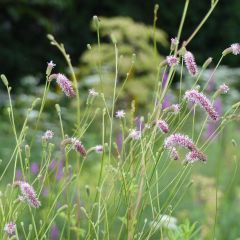
Sanguisorba tenuifolia var. purpurea
- Flowering time September, October
- Height at maturity 1,40 m
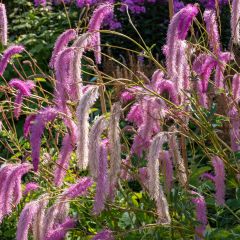
Sanguisorba hakusanensis
- Flowering time August to October
- Height at maturity 1,20 m
Discover other Sanguisorba
View all →Available in 2 sizes
Available in 1 sizes
Available in 0 sizes
Available in 1 sizes
Available in 1 sizes
Available in 1 sizes
Available in 1 sizes
Available in 2 sizes
Available in 1 sizes
Available in 2 sizes
Young plantation
Where to plant?
Grow the herb in full sun or light shade. In northern France, prefer sunny exposures to ensure it receives maximum light. In the south, a partially shaded position will be beneficial.
Plant it in well-draining soil. Sanguisorba minor prefers rather dry soils, while most other varieties (notably Sanguisorba officinalis) require soil that remains moist (especially if you live in southern France!). In the coldest regions, avoid soils that remain waterlogged in winter (you can plant on a mound or slope to facilitate water drainage). Don’t hesitate to add some gravel or pumice during planting to promote drainage!
Sanguisorbas will thrive in fertile, humus-bearing soil, except for Sanguisorba minor, which can tolerate poor and fairly dry soils. Sanguisorbas also prefer calcareous substrates.
As it enjoys dry soils, Sanguisorba minor can be planted in rockeries! Create a rocky bed alongside other plants suited to dry conditions. You can also grow the herb in a pot. Ensure you use a sufficiently large container and place a drainage layer at the bottom.
When to plant?
Plant the sanguisorba in spring or autumn, avoiding periods of frost or extreme heat.
How to plant?
- Start by placing the root ball in a basin filled with water to moisten it and facilitate recovery.
- Dig a planting hole. You can add some gravel or pumice to improve drainage, especially if you are growing Sanguisorba minor. Feel free to enrich the soil with well-decomposed compost.
- Place your sanguisorba in the planting hole.
- Replace the soil around it, then firm it down.
- Water generously.
You can apply a mulch to keep the soil cool and limit the growth of weeds. Continue to water regularly during the first few weeks after planting.
→ Also discover how to grow a sanguisorba in a pot!
Maintenance
We advise you to stake the tallest varieties, especially if they are exposed to winds. The stems are thin, flexible, and tall: in a species like Sanguisorba canadensis, which can reach 2 metres, the plant could easily fall over with the slightest gust of wind. Place a few stakes around the clump and tie it with string. To avoid staking, you can also wedge the sanguisorba between other plants with a sturdier habit, against which it can lean.
Except for Sanguisorba minor, which tolerates drought quite well, most sanguisorbas naturally grow in cool, even moist, soils and therefore require regular watering. We suggest adding a thin layer of mulch at the base of your sanguisorbas, as this will help maintain soil moisture.
You can cut back the faded stems to prevent self-seeding and prolong flowering (as this encourages the appearance of new flowers!). At the beginning of spring, cut back the dried stems and leaves for aesthetic purposes and to encourage the development of new shoots. We recommend dividing the clumps after a few years to aerate them, but also to contain their growth, as sanguisorbas can sometimes spread due to their rootstock.
Sanguisorba is rarely affected by diseases. The most common pests of burnet are slugs and snails, which sometimes nibble on the young leaves. You can place wood chips or ash around your plants to create a barrier.
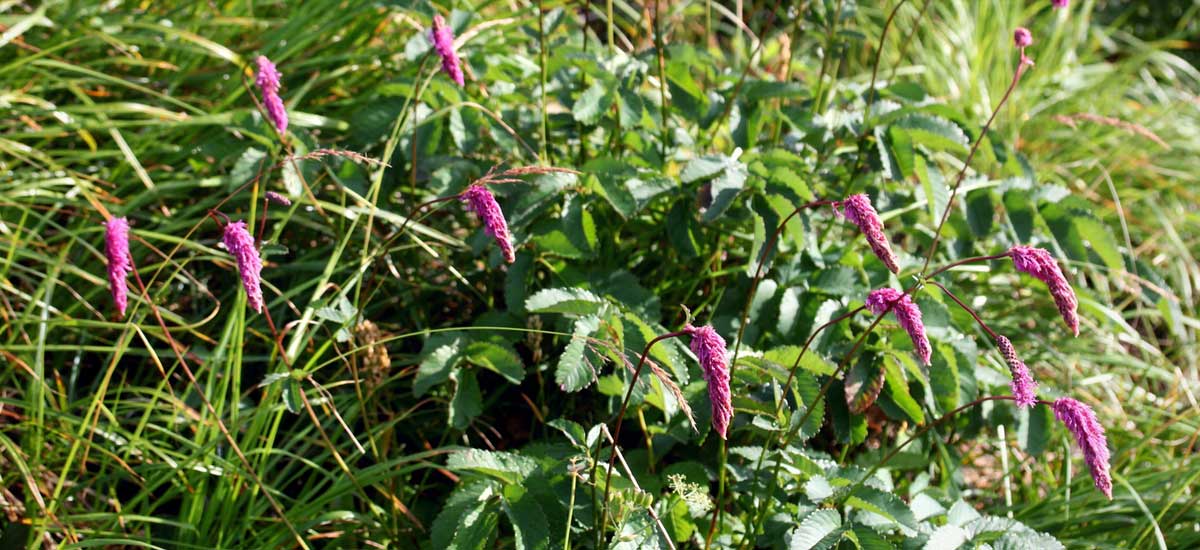
Sanguisorba hakusanensis (photo Alpsdake)
Multiplication
Sowing
You can sow the burnet in spring or autumn. However, the seeds take a long time to germinate and develop, which is why we recommend dividing clumps instead.
- Prepare pots by filling them with potting soil. Water and gently firm down.
- Sow the seeds.
- Cover them with a thin layer of substrate.
- Place your young plants under a cold frame.
- Ensure that the substrate remains moist until germination.
- As soon as the young shoots are large enough, transplant them into individual pots.
Sanguisorba minor and Sanguisorba officinalis can be sown directly in the garden, preferably in early spring. Work the soil by removing weeds and larger stones. Sow, then cover with a thin layer of potting soil and water. Continue to water regularly in the following weeks.
Division of Clumps
Burnets have running rootstocks, allowing them to spread. You can multiply the plant by taking divisions. We recommend dividing it every four to five years to aerate the clumps and rejuvenate them. Do this in early spring.
Identify a dense clump and lift it from the ground using a fork. You can remove excess soil around the roots. Separate the clump into several pieces, possibly using pruning shears. Replant in a new location, having prepared the ground beforehand. Water generously. Ensure that the substrate remains moist in the following weeks, allowing the new plants to establish.
Association
Its light flowering allows Sanguisorba to find its place in naturalistic-style gardens. Accompanied by grasses such as Calamagrostis, Stipa pennata or Miscanthus, it will immediately create a lovely countryside atmosphere. You can also choose Pennisetum setaceum, whose red-purple hues will beautifully complement the sanguisorbas. Give your garden a wildflower meadow feel by pairing the burnet with other plants that have a very airy appearance, such as Cirsium rivulare ‘Atropurpureum’, or the elegant inflorescences of the teasel, Dipsacus sylvestris. Also enjoy the white umbels of the Apiaceae, such as Selinum wallichianum. These light inflorescences will give the impression of being suspended above the flowerbed. To add more colour, you can include scabious, penstemons, and Verbena rigida. On the edges, this creates a contrast with the well-maintained appearance of a lawn, giving your garden a very lively and colourful side!
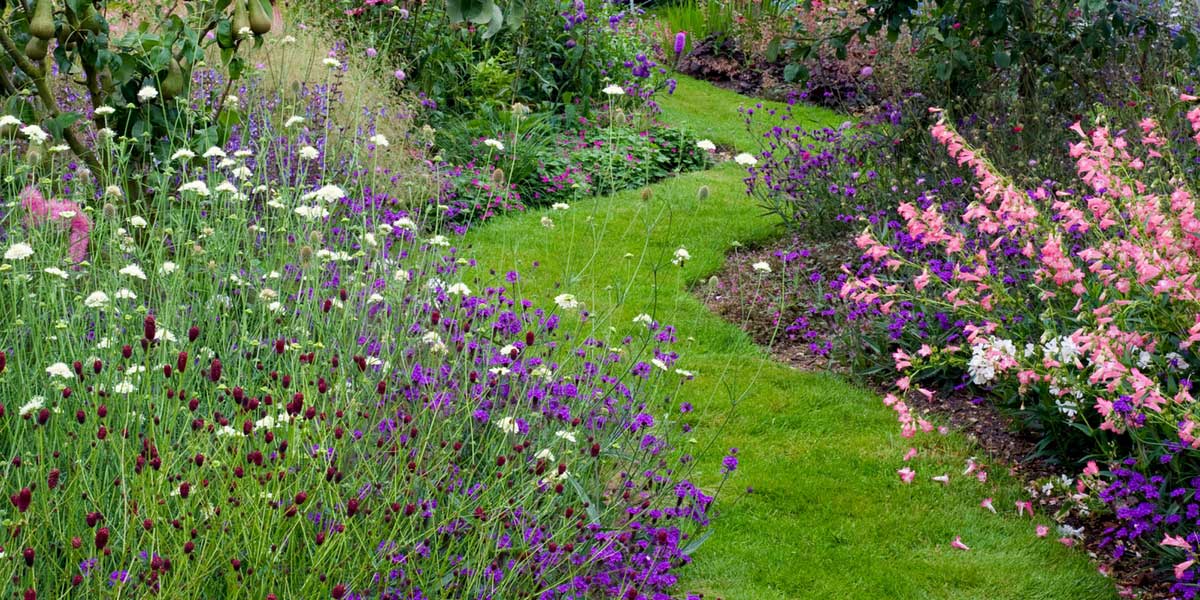
Sanguisorba, Verbena rigida, Penstemon, Scabiosa columbaria (Credit Photo Juliette Wade – GAP)
Sanguisorba minor is suitable for dry soils… It will easily find its place in a rockery! Plant it in a mineral setting, alongside Armeria maritima, Eryngiums, and a few clumps of grasses. This flowerbed will require very little maintenance.
Use sanguisorba to create a colourful flowerbed! Plant it alongside salvias, agastaches, heleniums, or daylilies. You can choose varieties with pink flowers, such as Sanguisorba obtusa, or those with dark flowering (like Sanguisorba officinalis ‘Tanna’), to bring more intensity to the flowerbed. You will achieve a beautiful contrast effect by combining the light flowering of sanguisorbas with the large, colourful flowers of daylilies!
Take advantage of sanguisorbas to play with colours. Pair them with other plants in red-purple tones, such as Astrantia ‘Ruby Star’, penstemons, Cosmos atrosanguineus, or Centranthus ruber. Optionally, add some white flowers to create a contrast. You can also compose a flowerbed in pink-white tones, by combining for example Sanguisorba obtusa or S. hakusanensis with Japanese anemones and Bleeding Hearts (Dicentra spectabilis). Other flowers in soft, pastel shades will contribute to a romantic feel. You can also add some campanulas, such as Campanula lactiflora, and some baby’s breath (Gypsophila paniculata)!
Take advantage of the light flowering of sanguisorbas to play with the wind! Compose a flowerbed where the flowers undulate at the slightest breeze, by planting Sanguisorba tenuifolia ‘Alba’ with grasses, such as Stipa pennata, Pennisetum, or Briza media! Prefer airy flowers, such as baby’s breath. Choose plants in white-cream-brown tones to create a very timeless effect. Your garden will exude a sense of softness, like a caress, like a feather…
You can also plant sanguisorbas at the edge of a pond, as most varieties (except Sanguisorba minor) enjoy soils that remain cool. Place alongside them some ferns (osmunda, matteuccia…), Myosotis palustris, Carex, Meadowsweet (Filipendula ulmaria), or Asian Primroses. You will achieve a lush and cool garden, ideal for recharging your batteries!
Did you know?
- Burnet, an edible and medicinal plant!
The small burnet, Sanguisorba minor, has medicinal properties, including antiseptic and haemostatic (it stops bleeding) effects. It can be used in infusions to treat sunburn. The leaves are edible: they have a cucumber-like taste and are rich in vitamin C. You can use them to flavour sauces, salads, and various dishes. The small burnet was once commonly grown in kitchen gardens.
Useful resources
- Discover our range of sanguisorba!
- Our video tips – How to plant perennials?
- Get inspired by this naturalistic atmosphere to combine sanguisorbas in the garden!
Frequently asked questions
-
The leaves of my burnet are being nibbled!
The culprits are slugs and snails, which tend to eat young leaves. You can protect your plants by placing ash or wood chips all around to stop them.
- Subscribe!
- Contents

































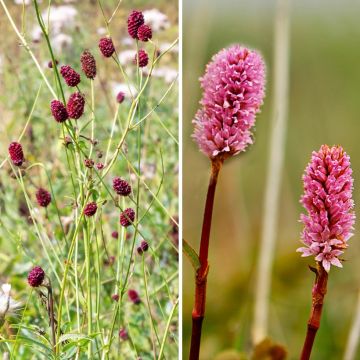
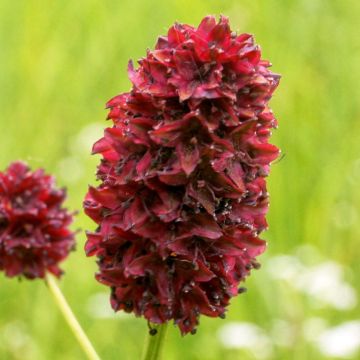
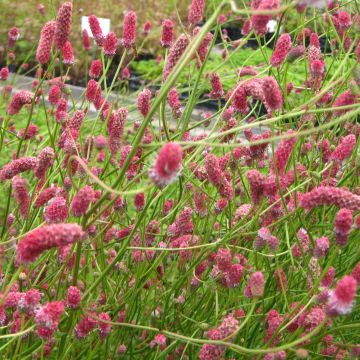

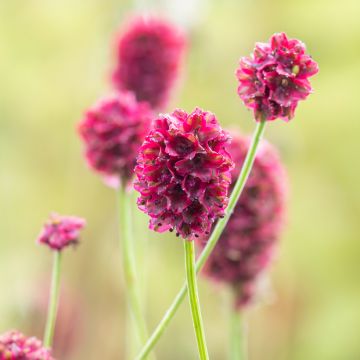

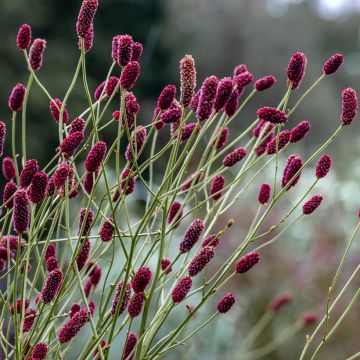

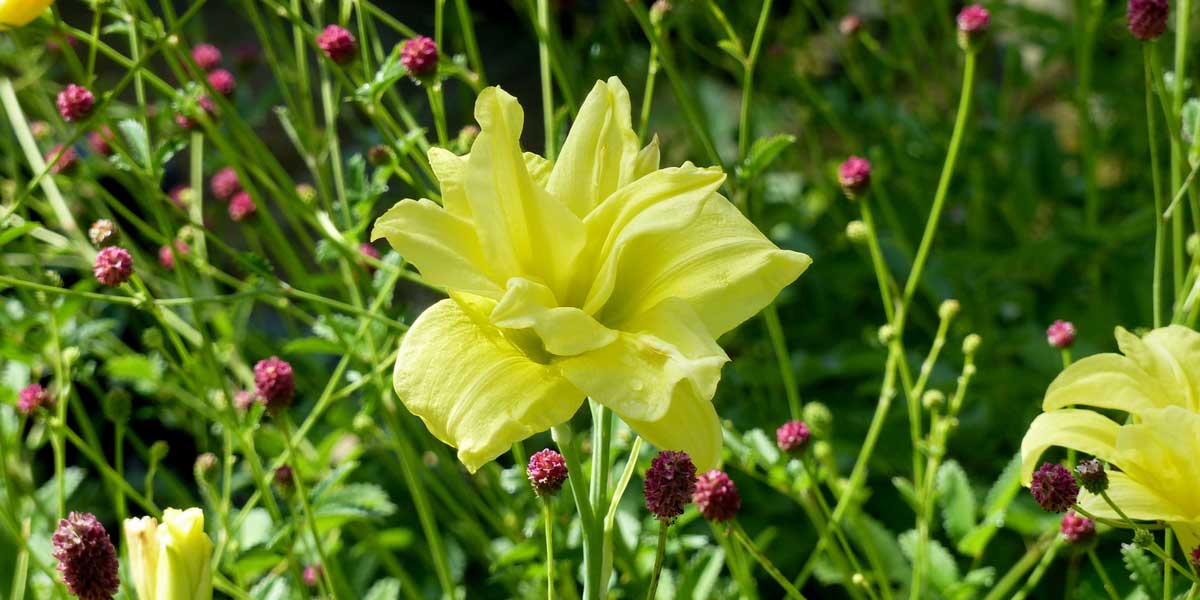
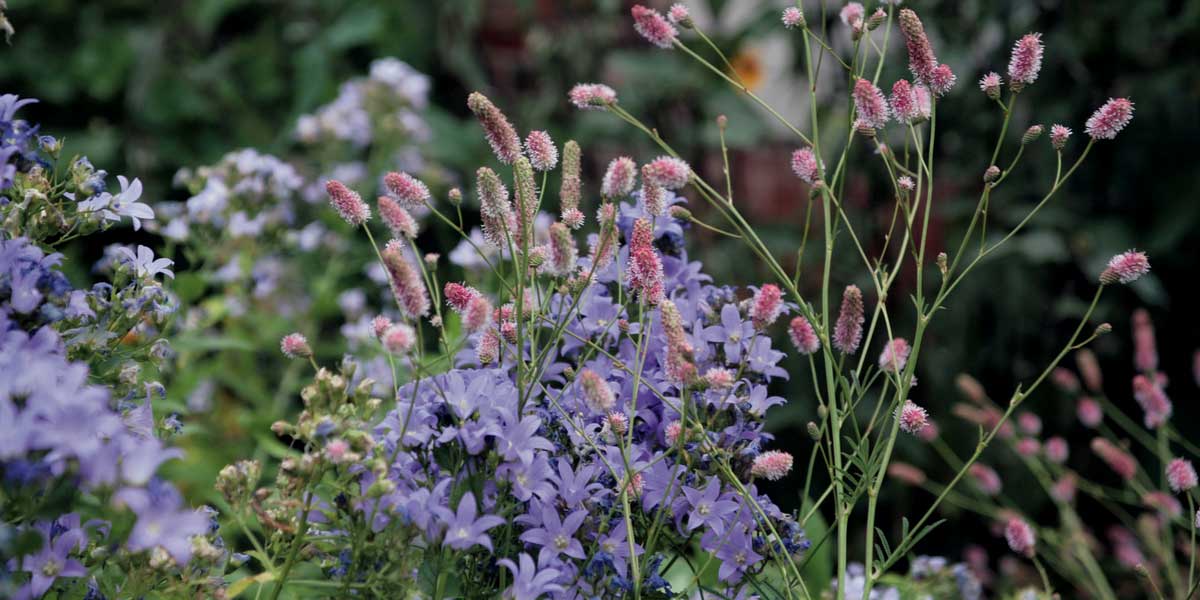
Comments